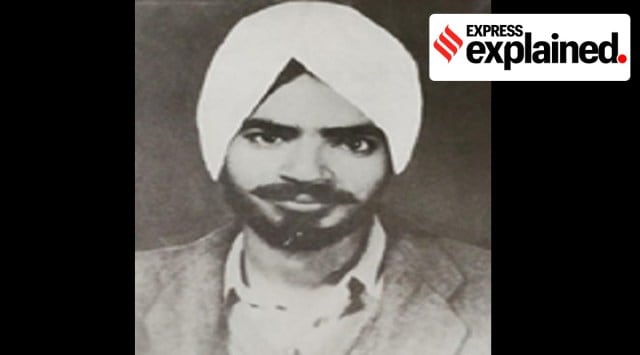Who was Karnail Singh Isru, the Punjabi leader who died during the Goa Liberation Movement?
Isru, along with satyagrahis, participated in a march from Pune to Goa in 1955 at a time when the state was under Portugese colonial rule.
 Every year, the Punjab government organises a function in memory of Isru that sees participation from the Chief Minister. (Photo via amritmahotsav.nic.in)
Every year, the Punjab government organises a function in memory of Isru that sees participation from the Chief Minister. (Photo via amritmahotsav.nic.in) On India’s Independence Day this year, Punjab Chief Minister Bhagwant Mann paid his tributes to the late activist Karnail Singh Isru, who died on the same day in 1955 while participating in the Goa Liberation Movement for the state’s accession to India.
Every year, the Punjab government organises a function in memory of Isru that sees participation from the CM. Political parties of the state, such as the Shiromani Akali Dal (SAD), also organise commemoration meetings.
Who was Karnail Singh Isru?
Isru was born on September 9, 1930, in the Chak 30 village of the Lyallpur district that is now in Pakistan. At the age of seven, his father Sunder Singh died and he was raised by his mother Harnam Kaur. Isru would go on to be inspired by the freedom movement against colonial rule that was at its peak at the time, with Punjab as a hotbed of the struggle.
He was earlier known as Karnail Singh Benipal, but after his family shifted to the village of Isru and following his death, the village’s name became associated with him. Later on, Isru started teaching at a government school in a Ludhiana village. He married Charanjeet Kaur but before the two could live together, he would join the Goa Liberation Movement.
How Isru joined the freedom struggle for Goa
After he raised the issue of fee hikes in his school in Khanna, Isru became the student union’s president. He would become greatly inspired by the freedom struggle’s heroes, such as Bhagat Singh, Chandra Shekhar Azad, Udham Singh and others, and the rationalist ideals they championed.
In the early 1950s, he joined the local unit of the Communist Party of India (CPI). Though the country had achieved independence by then, the territories of Goa, Daman and Diu, and Dadra and Nagar Haveli were still under Portuguese rule. In mid-1955, CPI decided to send Satyagarhis (followers of the Gandhian principles of truth and non-violence) to Goa for continuing the fight against colonial rule. Their aim was to hoist the Indian tricolour in Goa on Independence Day.
What was the Goa Liberation Movement and how did Isru join it?
Goa became a Portuguese colony in 1510 when Admiral Afonso de Albuquerque defeated the forces of Bijapur’s sultan, Yusuf Adil Shah.
Similar to the anti-British nationalist movement in the rest of India around the twentieth century, Goa started to witness an upsurge of nationalist sentiment against colonial rule in the early 20th Century. Leaders such as Tristão de Bragança Cunha, celebrated as the father of Goan nationalism, founded the Goa National Congress at the Calcutta session of the Indian National Congress in 1928.
In 1946, the socialist leader Ram Manohar Lohia led a historic rally in Goa that gave a call for civil liberties and freedom, and eventual integration with India, which became a watershed moment in Goa’s freedom struggle. But among the national leaders and parties, there was disagreement over how the matter was to be handled and how much pressure was to be exerted.
Isru left his home and only informed his family that he was taking part in the Movement by a postcard later on. He reached Pune on August 14, 1955, and a batch of Satyagarhis began their march towards Goa. They were led by a young widow named Sahodrabai Rai, who hailed from the Bundelkhand region.
However, as soon as they entered the Patradevi village in North Goa, the Portuguese forces opened fire on the Satyagarhis. A bullet hit Rai in her arm. Isru was then also hit by a bullet in his chest, resulting in his death at the age of 25.
The Indian government would go on to harden its position on Goa, demanding its integration happen “either with full peace or with full use of force”. December 18 and 19, 1961, saw a full-fledged military operation termed ‘Operation Vijay’, which was carried out with little resistance and an instrument of surrender was signed, leading to Goa’s annexation by India. Goa would be liberated on December 19, 1961.
How is Karnail Singh Isru remembered in Punjab and Goa?
A statue, village library, park and a senior secondary school in Isru’s name have been established in his village in Punjab and a stadium is under construction.
In 2015, a bronze bust of Issru was installed in the primary school of Patradevi village in Goa. State CM Pramod Sawant Visited Chandigarh last year and later went to the Barola village of Ambala, where he met Isru’s widow Charanjeet Kaur.
She was given Rs 10 lakh and Sawant promised to rename the road leading to Goa International Airport after Isru. He also declared that anyone visiting from Isru village to Goa will be treated as a state guest. Last year in November, a few villagers and Isru’s relatives had gone to Goa along with the village sarpanch, demanding that the condition of the primary school, where his bronze bust has been installed, should be improved.
- 01
- 02
- 03
- 04
- 05





































